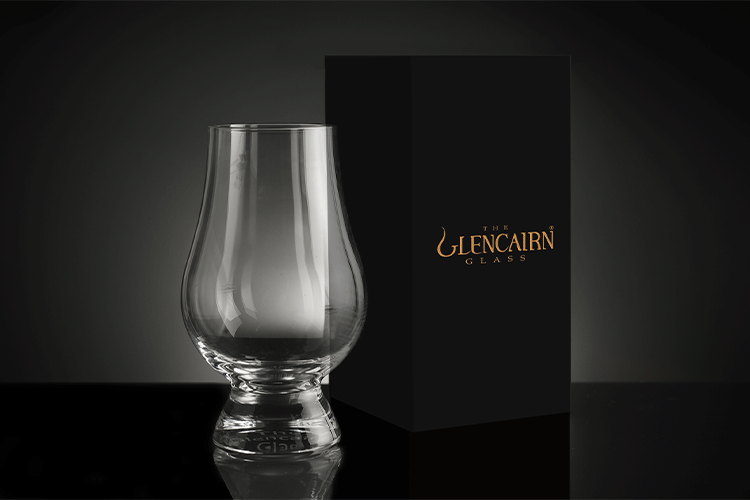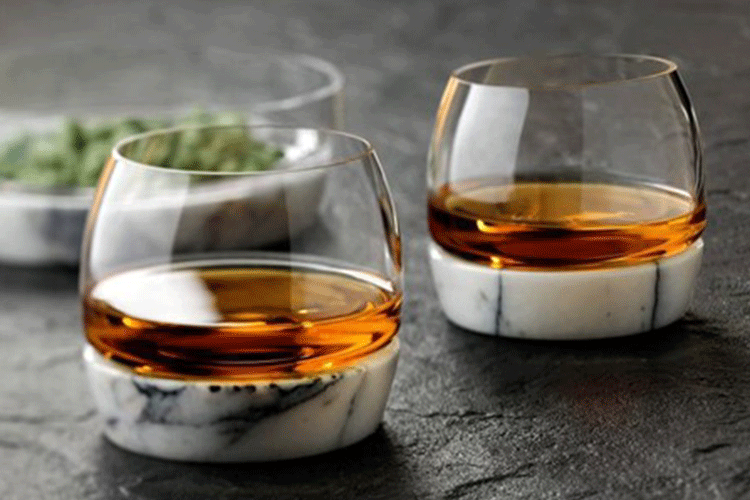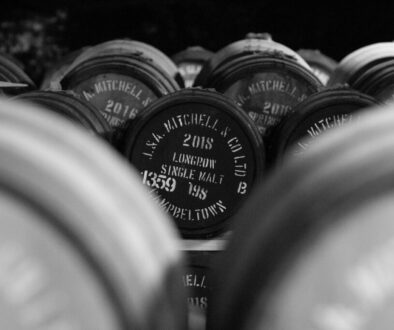Despite a previously long standing debate, there is now a general consensus that the shape of the glass used to drink whisky affects the nose and finish of the spirit to a surprisingly large extent. Changing the glass you use is one of the quickest and most affordable ways to level up your whisky game. Here at Mark Littler LTD, we’ve put together the ultimate guide to the different types of whisky glasses to help you get the most out of your whisky.
Out With The Old?
Typically, when ordering a dram in a pub or restaurant you would expect to receive it in a 10oz straight-sided tumbler with a wide rim and heavy base. This has been the standard whisky glass since the 19th century. However, in the last 30 years, the drinking vessel for whisky has been diversifying and people are not so quick to pour themselves a dram in a tumbler. So what has changed?

The biggest problem with the tumbler for whisky aficionados is the wide rim. A large surface area primarily encourages the alcohol content of whisky both in smell and taste and causes nose burn, which prevents other notes such as floral or spice from being appreciated. In addition to this, the wide rim also facilitates more rapid evaporation of the whisky which results in quickly fading flavours.
However, this is not to say that the tumbler should be discarded altogether. One of the most important factors when choosing a whisky glass is context. If you are drinking whisky to smell and taste every note and to compare one dram to another, then perhaps a more modern glass, such as the Glencairn, would be best suited. However, if you’re having a casual drink with friends in a pub or at home then a tumbler would do just fine.
For those looking to get the most out of their whisky, if not a tumbler… then what?
The Anatomy Of A Whisky Tasting Glass
There are 4 different parts that make up a whisky glass and each one can have an effect on the aroma, flavour, and finish of a whisky:
- Rim: the rim of the glass can determine how quickly the aromas dissipate from the whisky and how quickly the liquid will evaporate; a wide surface area encourages evaporation.
- Neck: the width of the neck can alter how concentrated the aromas of the whisky are; a narrower neck will funnel the aromas towards the nose.
- Bowl: the size of the bowl determines what the glass can be used for; a 10oz tumbler or a highball can be used for whisky cocktails, whereas the smaller Norlan glass or Glencairn have a much smaller bowl resulting in them being for neat whisky.
- Stem: the length and weight of the stem can affect the in the hand feel of the glass and prevent contaminate aromas from the hands.
The Different Types of Whisky Glass
Glencairn Glass

Designed by: Raymond Davidson
Shape: Short stem, tulip shape bowl, narrow rim
Buy now
If you are a whisky fan to any degree then you’ve probably tasted whisky from a Glencairn glass. The Glencairn glass was designed by Raymond Davidson of Glencairn Crystal in 2001 after he became tired of the tumbler. In issue 66 of Whisky Magazine, Davidson laments about the tumbler as it “does little to enhance the aromas of a dram” and mentions that he had begun to ask for whisky in a wine glass. With a desire to create something new, Davidson took inspiration from the copita glass used for sherry tasting, featuring a tulip shape and narrow rim. The narrow rim prevents the emphasis of alcohol and nose burn – two problems that affected the tumbler – which makes it fantastic for nosing whisky as the more subtle flavours can be appreciated. However, the narrow rim had to be widened slightly from the original sherry copita glass in order to make it easier to drink from. This tulip shaped bowl is then combined with a short, heavy stem to create the Glencairn glass.
Glencairn Crystal claim that the Glencairn glass is the definitive glass around the world and, whilst it may be a hard claim to prove, it is undeniable that Glencairn have opened up the world of whisky glasses and been incredibly successful, selling over 3 million glasses per year. 2020 marked the 20th anniversary of the Glencairn whisky glass.
Tulip/Copita Glass

Shape: Tulip shape bowl with flared rim and truncated stem
Buy now
The traditional copita glass, or tulip glass as it is often known, is the industry standard shape for whisky tasting and critically assessing. The Glencairn glass was heavily inspired by the copita and, as such, they have very similar qualities. The traditional copita varies by having a long truncated stem. The stem helps keep a temperature controlled whisky as it prevents the hand from warming it. The bowl, neck, and rim of the glass are almost exactly copied by the Glencairn glass which is largely why the Glencairn has not succeeded the copita as the industry standard.
Copita shaped whisky glasses are produced by many glassmakers to suit a wide range of budgets.
Highball

Designed by: Wrześniak Glassworks
Shape: Tall straight sides, heavy base and stemless
Buy now
The highball glass is really the odd one out of this list, having many different variations despite similar uses. Highball glasses are often 10fl.oz or similar, which means that they’re typically used for cocktails. The heavy base and straight sides of the highball makes them comfortable to hold and drink from easily which is ideal for the longer drinking time of a cocktail. The wide rim means that this glass is near impossible to nose from which is why it’s ideal for a mixer or ice.
Thistle Glass

Designed by: Riedel
Shape: Thistle shape, short stem and narrow rim
Buy now
One of the earliest alternatives to the tumbler, the thistle shaped whisky glass, was designed by Riedel Glass company in the early 1990s. This thistle shape seeks to solve the problems of the tumbler by maintaining the straight sides whilst also having a narrow and slightly tapered rim. This serves to prevent the flavour profiles from dissipating whilst simultaneously reducing the problem of alcohol nose burn. The slightly tapered rim draws the whisky to the front of the tongue where sweetness is captured which means that any sweetness in the whisky will be immediately highlighted.
Although the Riedel thistle glass has plenty of fans in the whisky world for its nosing qualities, it didn’t create quite the storm that the Glencairn went on to do just 8 years later. Riedel have since released variants of their whisky glasses, most featuring the tulip shape, in addition to the vast array of tumblers they produce.
NEAT Glass

Designed by: George Manska
Shape: Dramatic thistle, wide rim with narrow neck
Buy now
Created in 2002, the NEAT glass uses improved science in an attempt to enhance the whisky experience. An acronym for Naturally Engineered Aroma Technology, the NEAT glass has a dramatic thistle shape including a wide rim with a narrow neck. This shape allows the alcohol vapours to pass out of the glass whilst the more subtle flavours remain in the narrower neck. The NEAT glass also claims a temperature control function, albeit perhaps a simple one: it can be held at the base to warm the spirit or the neck to keep it cool. The flared shape of the glass also helps direct the whisky around the whole mouth, rather than just one area of the tongue as is the case for most glasses.
The NEAT glass has been used in 27 different tasting competitions and has found success not only with whisky, but with rum, brandy, and vodka too.
Experimental Shapes
As more whisky glasses are being produced, their shapes are becoming more experimental, resulting in whisky glasses that can no longer fit into the previously established categories. There are two newer emerging glass companies that appear to be achieving great success in the whisky drinking world.
Norlan Glass

Designed by: Sruli Recht and Jim McEwan
Shape: Stemless, flared rim with a heavy base
Buy now
The Norlan whisky glass was created via kickstarter in 2015 and released for purchase in 2016, making it the newest glass on this list. The Norlan is designed to replicate the hold feel of a tumbler, with a heavy base and short bowl whilst improving the nosing quality by emulating the curved rim of the tulip shaped glass. The double-walled structure prevents any contaminants of the whisky aroma, helps control temperature, and intensifies the colour. Refined by former Bruichladdich Master Distiller Jim McEwan, this glass has been created with both the casual drinker and the aficionado in mind.
Already in its short lifespan the Norlan glass has won 5 awards and is held in high regard amongst whisky lovers. The double-walled structure of the Norlan could facilitate a return to the tumbler style whisky glass whilst preserving the nosing qualities of other styles.
Nude Glasses

Designed by: Nude Design Team
Shape: tumbler-esque, heavy marble base with slightly narrower rim
Buy now
The second newly emerging whisky glass is the Nude glass which was created in 2014 as a contemporary branch of longstanding glassmakers Sisecam, established in 1935. The glass featured on this list is the Chill, one of multiple whisky glass ranges Nude have created. These glasses lean more toward the traditional tumbler with some minor alterations. The bowl is ever so slightly curved so that the rim is narrower which, as previously explained, helps dissipate the alcohol fumes and makes it easier to identify subtle flavours. The marble base of the Nude glass also helps maintain a cool whisky, a rather innovative temperature control method.
Although this Nude glass has been ranked highly by many reviewers, it seems that it has been designed for the casual drinker rather than the noser, as it’s more of an aesthetic design than it is technical.
How To Choose?
Now you know all there is to know about the different types of whisky glasses, which should you be using? The short answer to that question is… it depends. As mentioned at the beginning of this list, the main thing to consider when choosing a whisky glass is the context in which you’re drinking the whisky.

If you are casually enjoying a drink then a straight-sided tumbler or the Nude Chill would look and feel great while serving your whisky. There is a reason the tumbler was used by whisky drinkers for over a century, it suits the needs of the common drinker.
If you’re looking to taste the whisky, identifying the flavour profiles and aromas, then the glass you are choosing will make more of a difference. Here are the top 3 and how you should be using them.
The Riedel thistle glass or tulip shaped glasses suit serious tasting more than drinking for enjoyment.The industry standard for whisky assessment is still the sherry-style copita (tulip) long stemmed glass despite the popularity of the Glencairn. The flared rim of the thistle and tulip glasses helps soften the alcohol that the Glencairn so forcefully concentrates, ensuring that other flavour notes can be detected. These glasses are therefore better suited to a wider range of whiskies, making them more useful as tasting glasses. The thistle and tulip glasses are particularly good for those who prefer a sweeter and more delicate whisky. This makes it ideal for drams such as the Glen Moray 12 Year Old as it is floral and fruity.
The Glencairn, the most renowned whisky glass, is good as a middle ground glass. Whilst it has been criticised for being forceful when nosing – it’s often remarked that there’s no hiding anything in a Glencairn – it has the shape that allows for nosing whilst also being a comfortable drinking glass for pub-goers. The Glencairn is particularly good for those who enjoy the heavily peaty flavours in whisky and don’t mind a little more of that nose burn effect. The Glencairn is ideal for whiskies such as the Ardbeg Still Young or Bowmore 1980s 12 Year Old.
However, if you’re looking for a whisky glass that you can critically assess with, enjoy whisky with, and look good with, then the Norlan whisky glass is the one you should be looking at. The Norlan glass takes the best aspects of all of its predecessors and seeks to eliminate their problems. The flared rim of the glass helps dissipate the alcohol fumes but is still narrow enough that the other aromas remain. The double-walled structure enables temperature control and the heavy base and overall shape of the outside layer is reminiscent of the tumbler. The Norlan whisky glass is a fantastic all rounder and an excellent place to start for a whisky drinker wanting to try their hand at nosing and critically assessing whisky.
What Are The Experts Saying?
“I have lots of different favourite glasses – depending on my mood, occasion etc.. If it’s just for nosing/analysing whisky then my go to for “work” is the Copita from Glencairn. It’s my go-to for nosing and writing tasting notes. It’s become a bit of a benchmark for me as I know what to expect from the glass so it’s almost become its own reference for me as that stays the same but the whisky in glass changes.
For whisky highballs: I absolutely love the highball glasses from Isle of Harris and I also have a set of their beautiful martini glasses too which are perfect for Manhattans/Rob Roys.”
– Blair Bowman (Whisky Consultant & Author)
“It depends on the situation. For assessing whisky, either for the [YouTube] channel or in a casual blind tasting etc then I’ll favour a tulip style glass, either a glencairn or a copita. When I’m drinking with buddies or relaxing with a nightcap, I always reach for a nice cut glass tumbler”
– Vin PF (No Nonsense Whisky on YouTube)



